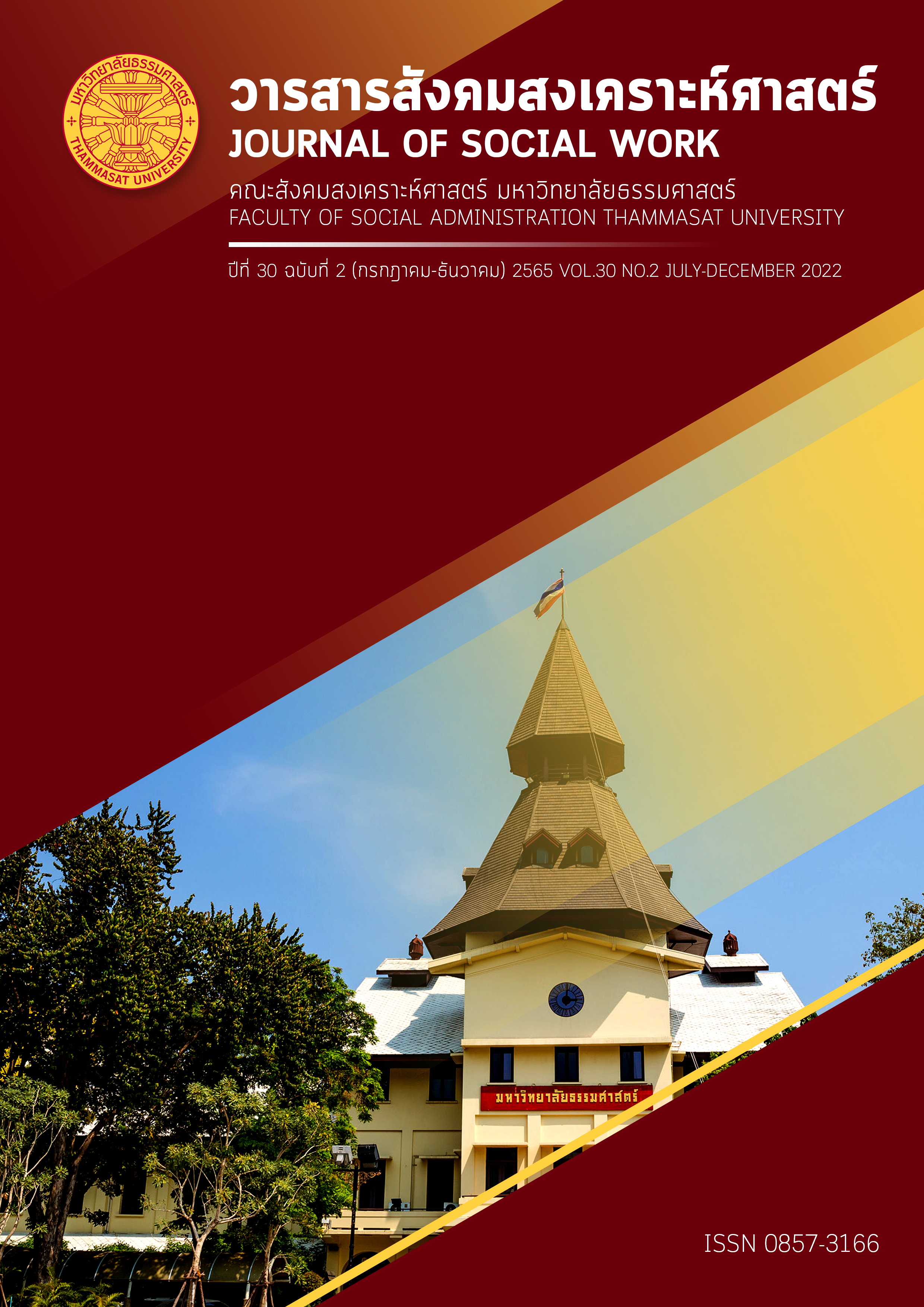Cyber Bullying in Public of Youth in the Bangkok Area
Keywords:
Cyber bullying, Mental health healing, Qualitative researchAbstract
This qualitative research features interviews with experts with the purpose of exploring the following; 1. The motivation or factors that cause cyber bullying, 2. The methods or processes of cyber bullying, 3. The effects of cyber bullying, and 4. The guidelines of protections, corrections and mental healing of cyberbullied victims. This particular study has been based on the opinions of experts providing essential information, from both the government and private sectors in Bangkok. A total of 16 persons were engaged through in-depth interviews.
The conclusion of this research is as follows:
1. The motivations, factors, or reasons which cause cyber bullying are discontent, dislike, hatred, disagreement, jealousy, as well as conflict of interest. All of the aforementioned factors lead to humiliating online posts, cursing, discrediting, all of which create both physical and mental damage. Moreover, the playing of pranks is also found to be a motivation, for example, teasing, mocking, which, in turn, cause the loss of reputation of others, unconsciousness, impetuousness, and ignorance.
2. The methods or processes of bullying are mainly observed in three components: 1) Verbal bullying 2) Social bullying and 3) Indecent bullying.
3. The effects of cyber bullying aredivided into three dimensions. The first represents the effect of cyber bullying on victims, the second dimension is the effect of cyber bullying on the bully himself or herself, and the third dimension reflects the effect of cyber bullying on society.
4. The study of the guidelines of protections, remedies, and mental health healings of cyber bullied victims is divided into two dimensions as follows: The first dimension is a guideline of protection for cyber bullied victims. The second dimension is a guideline of remedies and mental healing for cyber bullied victims. This guideline is to remedy and heal victims’ mental health when they are bullied or fall prey to cyber bullying. This guideline consists of the following five main areas: Psychological principles, Relationships with close friends, Religious principles, Protection of system and technology and Legal protection.
References
กนกอร จันยมิตรี และ กัญญ์ฐิตา ศรีภา. (2563). แนวทางการป้องกันพฤติกรรมการเบี่ยงเบนทางสังคมของวัยรุ่นจากการถูกกลั่นแกล้งทางไซเบอร์ ศึกษาเฉพาะกรณี โรงเรียนมัธยมศึกษาจังหวัดสมุทรปราการ. วารสารพฤติกรรมศาสตร์, 26(2), 116-141.
คณาธิป ทองรวีวงศ์. (2558). มาตรการทางกฎหมายในการคุ้มครองสิทธิบุคคลจากการกลั่นแกล้งรังแกออนไลน์ซึ่งนำไปสู่การฆ่าตัวตาย: ศึกษากรณีกฎหมายความปลอดภัยไซเบอร์. รายงานสืบเนื่องการประชุมวิชาการระดับชาติ “นวัตกรรมกับความท้าทายทางภาษาและการสื่อสารในโลกไร้พรมแดน” วันที่ 3-4 กันยายน 2558 ณ สถาบันบัณฑิตพัฒนบริหารศาสตร์. กรุงเทพฯ: สถาบันบัณฑิตพัฒนบริหารศาสตร์.
ชาญวิทย์ พรนภดล. (2561). อย่าปล่อยให้เด็กถูกกลั่นแกล้งในโลกออนไลน์ (Cyber Bullying). สืบค้นจาก https://www.dmh.go.th/news-dmh/view.asp?id=28079
ชาย โพธิสิตา. (2554). ศาสตร์และศิลป์แห่งการวิจัยเชิงคุณภาพ (พิมพ์ครั้งที่ 5). กรุงเทพฯ: อมรินทร์พริ้นติ้ง.
ณัฐรัชต์ สาเมาะ. (2556). การรับรู้ของเยาวชนต่อการรังแกในพื้นที่ไซเบอร์. ปริญญานิพนธ์ศิลปศาสตรมหาบัณฑิต, สาขาสังคมศาสตร์การแพทย์และสาธารณสุข, บัณฑิตวิทยาลัย, มหาวิทยาลัยมหิดล.
ทรงเกียรติ จรัสสันติจิต. (2560). Cyberbullying: ถ้ารักฉัน อย่ารังแกฉัน. สารอาศรมวัฒนธรรมวลัยลักษณ์, 17(1), 117-137.
ธัมมัฏฐิตตา อยู่เจริญ. (2562). เอกสารประกอบการสอนวิชา จว. 307 จิตวิทยาการฝึกอบรมเบื้องต้น. กรุงเทพฯ: คณะจิตวิทยา มหาวิทยาลัยเกษมบัณฑิต.
บุญเสริม หุตะแพทย์ และคณะ. (2552). รายงานการวิจัยฉบับสมบูรณ์สื่อและความรุนแรงจากสื่อต่อเด็กและเยาวชนไทย = The media and effects of media violence on the Thai children and adolescents. นนทบุรี: สำนักพิมพ์มหาวิทยาลัยสุโขทัยธรรมาธิราช.
ปรเมศวร์ กุมารบุญ. (2561). การส่งเสริมการศึกษาในวิชาอาชญากรรมไซเบอร์. วารสารวิชาการอาชญาวิทยาและนิติวิทยาศาสตร์, 4(2), 67-81.
ปองกมล สุรัตน์. (2561). สาเหตุและผลกระทบที่เกี่ยวข้องกับการรังแกผ่านโลกไซเบอร์: กรณีศึกษาเยาวชนไทยผู้ถูกรังแก. วารสารวิชาการสถาบันเทคโนโลยีแห่งสุวรรณภูมิ, 4(1), 260-273.
ปองกมล สุรัตน์, ฐาศุกร์ จันประเสริฐ และ นำชัย ศุภฤกษ์ชัยสกุล. (2561). กระบวนการรังแกผ่านโลกไซเบอร์ในเยาวชนไทย: การศึกษาแบบ
พหุกรณี. วารสารวิชาการสถาบันเทคโนโลยีแห่งสุวรรณภูมิ, 4(2), 61-79.
พิมพวัลย์ บุญมงคล และคณะ. (2558). การพัฒนาศักยภาพเครือข่ายโรงเรียนเพื่อลดความรุนแรงในพื้นที่ออนไลน์ในกลุ่มเยาวชน. กรุงเทพฯ: มหาวิทยาลัยมหิดล.
ภัทรธิรา ผลงาม. (2544). ความพึงพอใจและความต้องการของนักศึกษาระดับบัณฑิตศึกษาต่อกระบวนการการจัดการเรียนการสอนระดับบัณฑิตศึกษาสถาบันราชภัฏเลย. กรุงเทพฯ: กระทรวงศึกษาธิการ.
ภัทราพร เกษสังค์. (2559). การวิจัยปฏิบัติการ. กรุงเทพฯ: สำนักพิมพ์แห่งจุฬาลงกรณ์มหาวิทยาลัย.
เมธินี สุวรรณกิจ. (2560). มาตรการทางกฎหมายในการคุ้มครองเด็กและเยาวชนจากการถูกกลั่นแกล้งในสังคมออนไลน์. วารสารนิติศาสตร์มหาวิทยาลัยนเรศวร, 10(2), 60-61.
สุภาวดี เจริญวานิช. (2560). การรังแกกันผ่านพื้นที่ไซเบอร์: ผลกระทบและการป้องกันในวัยรุ่น. วารสารวิทยาศาสตร์และเทคโนโลยี, 25(4), 639-648.
องอาจ นัยพัฒน์. (2551). การออกแบบการวิจัย : วิธีการเชิงปริมาณเชิงคุณภาพ และผสมผสาน. กรุงเทพฯ: จุฬาลงกรณ์มหาวิทยาลัย.
ฤทัยชนนี สิทธิชัย และ ธันยากร ตุดเกื้อ. (2560). พฤติกรรมการรังแกบนโลกไซเบอร์ของเยาวชนในสามจังหวัดชายแดนใต้. วารสารวิทยบริการ มหาวิทยาลัยสงขลานครินทร์, 28(1), 86-99.
Agathi, S., Zoe, K., Dionisis, L., Panagiotis, M., Georgia, K., & Athanasios, S. D. (2018). Cyber Bullying and Traumatic Experiences: The Impact on Learning Disabilities. The International Journal of Engineering Science, 6(1), 74-87.
Agnew, R. (2001). General Strain Theory Building on the Foundation of General Strain Theory: Specifying the Types of Strain Most Likely to Lead to Crime and Delinquency. E-Journal of Research in Crime and Delinquency, 38(4), 319-361.
Allison, M. S., & William, J. F. (2012). Prevalence, Psychological Impact, and Coping of Cyberbully Victims Among College Students. Journal of School Violence, 11(1), 21-37.
Cohen, L., & Felson, M. (1979). Social Change and Crime Rate Trends: a Routine Activity. Approach. American Sociological Review, 44, 488 - 608.
Creswell, J. W. (1998). Qualitative Inquiry and Research Design: Choosing Among Five Tradition. Thousand Oaks: Sage.
Freud, S. (1964). Group Psychology and The Analysis of The Ego Sigmund Freud. New York: Bantam Books.
Glaser, B. G., & Strauss, A. L. (1967). The Discovery of Grounded Theory: Strategies for Qualitative Research. Chicago: Aldine Publishing Company.
Khruakham, S. (2015). Crime, criminology and criminal justice. Nakornpathom: Phetkasem.
Luthans, F., Youssef, C., & Avolio, B. (2007). Psychological capital. Oxford: Oxford University Press.
Plutchik, R. (1980). Emotion: Theory research and experience. New York: Academic.
Tuncay, A., & Mehmet, B. H. (2012). On Being Cyber Bully and Victim among Primary School Students. Elementary Education Online, 11(2), 369-380.
Downloads
Published
How to Cite
Issue
Section
License
Copyright (c) 2022 Journal of Social Work

This work is licensed under a Creative Commons Attribution-NonCommercial-NoDerivatives 4.0 International License.
The manuscripts published in the Social Work Journal is the copyright of the Social Work Journal, Thammasat University
Any article or opinion appeared in the Social Work Journal will solely be under the responsibility of the author The Faculty of Social Administration, Thammasat University and the editors do not need to reach in agreement or hold any responsibility.


